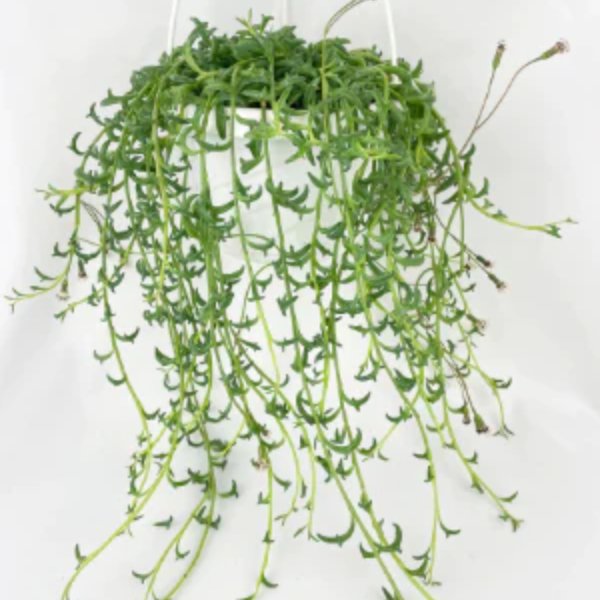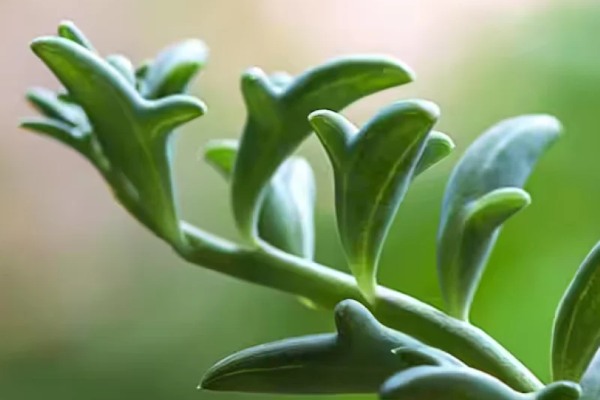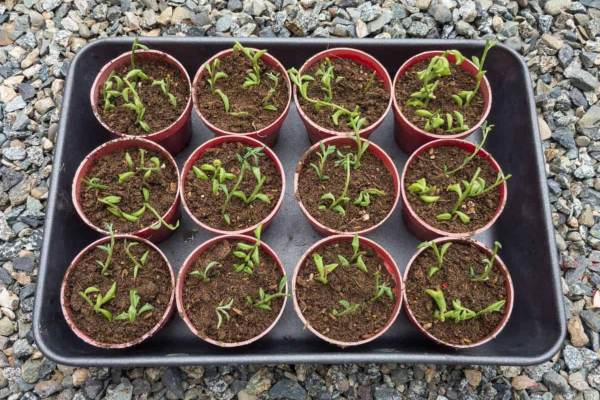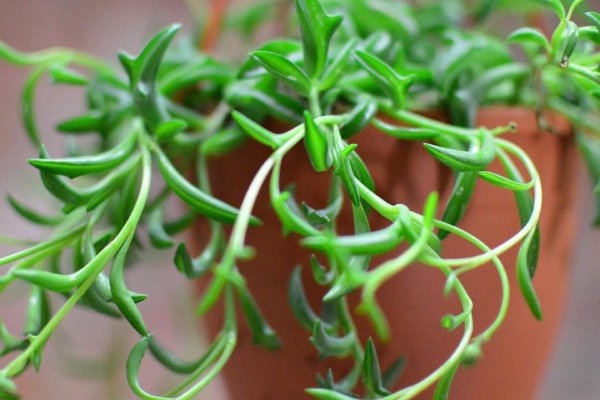String of Dolphins is a popular trailing succulent known for its leaves that look like tiny leaping dolphins. It has gray-green, glossy leaves that resemble a pod of dolphins. This houseplant is commonly grown in hanging pots. Similarly, it is a hybrid between the String of Pearla plant (Senecio rowleyanus) and the Candela plant or Hot Dog Cactus (Senecio articulates). In the spring and summer, it also produces small white flowers with a pleasant cinnamon scent. Unfavorably, this plant is mildly toxic to both humans and pets. Here we will discover more about this beautiful indoor plant.
Plant Descriptions
Plant Type: Succulent, Vine
Scientific Name: Senecio peregrinus
Common Name: String of Dolphins, Dolphin plant, Flying Dolphins, Dolphin Necklace
Genus: Senecio
Family: Asteraceae
Season: Spring
Native Area: Africa
Toxicity: Toxic to people, pets
Where and When to Plant String of Dolphins?
The String of Dolphins is a versatile plant that thrives both indoors and outdoors in warm climates. Many people grow this plant indoors due to its small, peculiar dolphin-shaped leaves. As it is a string plant, it is best to plant them in hanging baskets or along walls where they can cascade freely and create a beautiful, trailing effect. Besides, it is a toxic plant, hence, keep them away from pets and small children to avoid any health hazards. Like many cacti and succulents, the String of Dolphins can be planted or moved at any time of the year, but most preferably in spring and early summer. During these seasons, there is more sunlight and the weather remains consistently warm.

How to Care for a String of Dolphins
String of Dolphins plants is easy to care for and requires minimal effort. This indoor plant thrives in full sunlight and needs well-draining soil to prevent its roots from rotting. Although these vines are hardy in hot climates, they are usually grown indoors in most parts of the United States.
Here are some detailed care tips for growing a healthy String of Dolphins:
Light
String of Dolphins thrives in a bright, indirect light. It should get a minimum of six hours of direct sunlight daily. If put in full sun, the plant gets sunburned or leaf damage. However, the plant can gradually adjust to handle some direct sun in cooler climates. Inside the house, this potting should be placed beside a south-facing window. Still, it can be grown further inside the house in conditions of medium light.
Soil Preparations
This plant prefers soil that drains well. You can use a commercially available cactus or succulent mix for this plant and add a little organic matter to avoid root rot. Adding sand or perlite to the soil mix can help improve aeration, allowing the roots to breathe better.
Water
The String of Dolphins does not need lots of watering. Similar to other succulents, this one can store water in its plump leaves and stems. Water once a week during spring and fall, which is the active growth period, and once or twice a month during winter when it is in a dormant state. Make sure the soil dries out before the next watering to prevent root rot.
Temperature and Humidity
This plant thrives in dry, Mediterranean climates. When grown indoors, keep the temperature between 60-80°F. While it can handle slightly cold temperatures as low as 40°F, it is best to avoid extreme cold or frost. Further, the String of Dolphins will prefer moderate to high humidity levels. If you live in a drier climate, you can increase the humidity by misting the plant or putting a tray of water nearby.
Fertilizer
You don’t need to use regular fertilizers. However, fertilize the plant at least once a year in the spring at the start of the blooming season. You may use a natural NPK-balanced fertilizer in a ratio of 5-10-5. However, be careful not to over-fertilize, as this can cause the leaves to lose their unique shape.
Pruning
Pruning is best done in spring or summer when the plant is in full growth. Pruning encourages the plant to grow into a bushier shape. If your String of Dolphins has grown too leggy, you can cut or trim it back. The cuttings from pruning can be planted again in the pot to give it a fuller look.
Pests and Diseases
Common houseplant pests that affect the String of Dolphins are aphids, mealybugs, scale, and spider mites. These are all sap-sucking insects that seem minor but can cause severe damage if not treated. So, early detection and proper treatment can easily control these pests and keep your plant healthy. To get rid of pests, you can apply neem oil or insecticidal soap to the plants.

Propagating String of Dolphins
String of Dolphins plants are drought-tolerant and easy to propagate. You can grow new plants from stem cuttings placed in water or soil. The best times to do this are in spring and summer and thus, you will require only garden shears. Here is a step-by-step guide on how to grow a new String of Dolphins plant.
Step 1: Choose a healthy stem on the parent plant. Make the cut where there are at least 2-3 nodes and some leaves attached.
Step 2: Remove leaves from the bottom of one or two nodes to prevent them from rotting.
Step 3: Dip the cuttings in a glass or vase of water. Change the water every few days. You may place the vase in bright, indirect light which will help the roots to grow.
Step 4: Roots will start to grow within a couple of weeks. When the roots are ready, you can move the cutting into the soil.
Common Problems with String of Dolphins
String of Dolphins can face some common problems as it grows, so it is important to address them to keep the plant healthy. If the leaves start to shrivel, mostly it is because the plant is not getting enough water. Water deeply but let the soil dry out between watering. Also, avoid additional watering and poor drainage, as it may cause root rot. Well, overwatering and underwatering also cause to leaves fall off a plant. To prevent this, water only when the soil is completely dry, use a pot with drainage holes, and choose a well-draining soil mix.
If the leaves turn yellow or brown, then it could be that the plant is receiving direct sunlight. On the other hand, if it doesn’t get enough bright light, then it will be leggy with a faded green color. So, you need the right amount of bright indirect light to keep your String of Dolphins healthy.
Conclusion
In conclusion, String of Dolphins is a unique and captivating succulent that adds charm to any indoor or outdoor space with its dolphin-shaped leaves and cascading growth. While it is mildly toxic to pets and humans, its low-maintenance requirements make it a favorite among succulent enthusiasts. It requires minimal care, including bright light, well-draining soil, and watering. Similarly, the plant will remain robust and vibrant with regular pruning, fertilization, and pest management. With its simple propagation methods and resilience, the String of Dolphins can be a delightful addition to any plant collection.

Also read, 12 Low light succulents for your home or office
Frequently Asked Questions
1. What is the String of Dolphins plant?
String of Dolphins is a popular trailing succulent known for its leaves that look like tiny leaping dolphins. It has gray-green, glossy leaves that resemble a pod of dolphins.
2. Can a String of Dolphins produce flowers?
Yes, it does. It has small white flowers with a pleasant cinnamon scent and comes in spring and summer.
3. Can a String of Dolphins be grown outside?
Yes, String of Dolphins can grow perfectly well if planted directly outside in a warm climate.
4. What are the companion plants for String of Dolphins?
String of Dolphins prefer to grow with other succulents as well as trailing plants, like the String of Pearls, Jade Plants, and Echeverias.
5. What should I do if my String of Dolphins is becoming too leggy?
If your plant is becoming leggy, it may be due to insufficient light. Move it to a brighter location or adjust the light conditions to encourage fuller growth. You can also prune the plant to promote bushier growth and use the cuttings for propagation.
